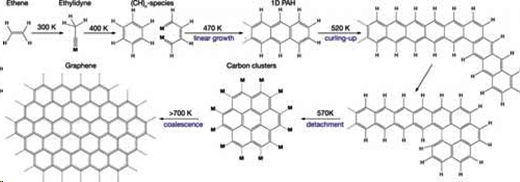|
NOVIDADES
An international team of scientists has developed a new way to produce single-layer graphene from a simple precursor: ethene - also known as ethylene - the smallest alkene molecule, which contains just two atoms of carbon. By heating the ethene in stages to a temperature of slightly more than 700 degrees Celsius - hotter than had been attempted before - the researchers produced pure layers of graphene on a rhodium catalyst substrate. The stepwise heating and higher temperature overcame challenges seen in earlier efforts to produce graphene directly from hydrocarbon precursors. Because of its lower cost and simplicity, the technique could open new potential applications for graphene, which has attractive physical and electronic properties. The work also provides a novel mechanism for the self-evolution of carbon cluster precursors whose diffusional coalescence results in the formation of the graphene layers.  Measured and theoretically simulated images of stages in the dehydrogenation process observed in programmed surface heating experiments. The sequence starts from adsorbed ethene (at 300K), leading to self-evolved 24-carbon-atom cluster precursors (between 570K and 670 K), and culminates with graphene formed at elevated temperatures (between 770K and 970K). Image: U. Landman and B. Yoon
"Since graphene is made from carbon, we decided to start with the simplest type of carbon molecules and see if we could assemble them into graphene," explained Uzi Landman, a Regents' Professor and F.E. Callaway endowed chair in the Georgia Tech School of Physics who headed the theoretical component of the research. "From small molecules containing carbon, you end up with macroscopic pieces of graphene." Graphene is now produced using a variety of methods including chemical vapor deposition, evaporation of silicon from silicon carbide - and simple exfoliation of graphene sheets from graphite. A number of earlier efforts to produce graphene from simple hydrocarbon precursors had proven largely unsuccessful, creating disordered soot rather than structured graphene. Guided by a theoretical approach, the researchers reasoned that the path from ethene to graphene would involve formation of a series of structures as hydrogen atoms leave the ethene molecules and carbon atoms self-assemble into the honeycomb pattern that characterizes graphene. To explore the nature of the thermally-induced rhodium surface-catalyzed transformations from ethene to graphene, experimental groups in Germany and Scotland raised the temperature of the material in steps under ultra-high vacuum. They used scanning-tunneling microscopy (STM), thermal programed desorption (TPD) and high-resolution electron energy loss (vibrational) spectroscopy (HREELS) to observe and characterize the structures that form at each step of the process.  Schematic of the pathway describing the evolution of adsorbed ethene (top left) to graphene (bottom left). The sequence of intermediates identified in the study and their respective appearance temperatures are indicated. Image: F. Esch, R. Schaub, U. Landman
At the final stage before the formation of graphene, the researchers observed nearly round disk-like clusters containing 24 carbon atoms, which spread out to form the graphene lattice. "The temperature must be raised within windows of temperature ranges to allow the requisite structures to form before the next stage of heating," Landman explained. "If you stop at certain temperatures, you are likely to end up with coking."  Schematic of the pathway describing the evolution of adsorbed ethene (top left) to graphene (bottom left). The sequence of intermediates identified in the study and their respective appearance temperatures are indicated. Image: F. Esch, R. Schaub, U. Landman
The resulting graphene structure is adsorbed onto the catalyst. It may be useful attached to the metal, but for other applications, a way to remove it will have to be developed. Added Landman: "This is a new route to graphene, and the possible technological application is yet to be explored." Georgia Institute of Technology. Posted: May 04, 2017. |
|||||||||||||||||||||||||